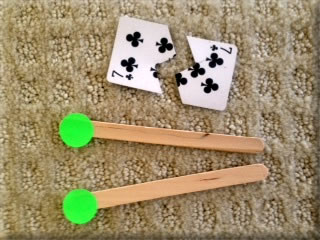Collaborators
Collaboration refers to two or more people working together toward a common goal. When individuals cooperate and work side-by-side they can create something that is greater than the sum of its parts.
Having children work with a partner can be a powerful teaching strategy. Through partner activities children can develop social skills, cooperation, problem solving, independence, oral language, and creativity. Scaffolding commonly occurs when one child with advanced skills helps a fellow classmate attain a higher level. To avoid common behavior problems that can occur when children pick their own partner, try one of these ideas!
 Buddy Sticks - Put like stickers on the bottoms of two craft sticks. (You will need as many sticks as there are children in your classroom.) Place sticks in a plastic cup with stickers facing down. Children choose a stick and then find the person whose stick matches theirs. That is their partner.
Buddy Sticks - Put like stickers on the bottoms of two craft sticks. (You will need as many sticks as there are children in your classroom.) Place sticks in a plastic cup with stickers facing down. Children choose a stick and then find the person whose stick matches theirs. That is their partner.
•For small group work, put like stickers on four sticks. Remember, groups of two or four are more conducive to social interaction.
Hint! When there is an odd number of students, let the last child choose whichever group she would like to be a part of.
Puzzle Pairs - Take valentines or other seasonal cards and cut them in half in puzzle shapes. Children put puzzles together to find their partner.
Partner Poem – Children face their partner, look them in the eyes and chant:
Hand to hand (shake hands)
And feet to feet (touch shoes)
I’m glad that you
Are partners with me!
Partner Projects – What can children do with a partner or in a small group?
| Read together. |
Clean up a center or each other’s desks. |
| Look at books or magazines together. | Build together with blocks, Legos, etc. |
| Whisper a prediction in each other’s ear. | Make shapes and letters with their fingers or bodies. |
| Read around the room. Give them pointers and empty glasses frames for more fun. |
Write the room. Give them clipboards and ask them to write words that would reinforce a skill you are working on. For example, they could write compound words, words with the “th” diagraph, two syllable words, etc. |
| Sing a song or say nursery rhymes together. |
Review information after a science lesson, social studies, etc. |
| Help with dressing, such a zipping coats and tying shoes. | Play with play dough or clay together. They make objects that begin with a certain sound, shapes, sets, etc. |
| Play a computer game. |
Review flashcards. |
| Guess who I am? Children dramatize or pantomime favorite books, rhymes, animals, etc. while their partner tries to guess. | Work on vocabulary. One child calls out a word while the other child gives the definition. |
| Play “Mirror.” One child is the leader and the other child is the “mirror” and must mimic what the leader does. Switch roles after a minute. | Practice spelling words. One friend calls out a word for their partner to spell. |
| Write on each other’s backs. | Do exercises together. |
| Retell a story. They can also discuss who, what, where, when, why, the problem, resolution, what might happen next, etc. | Draw a picture together. They could draw their favorite part of a story, illustrate a poem, draw a picture of their teacher, and so forth. |
| Do puzzles together. Edit each other’s writing. |
Check each other’s work. |
| Do a graphic organizer (Venn diagram, web, T-chart, time line, etc.). |